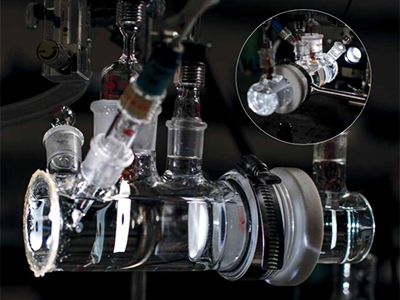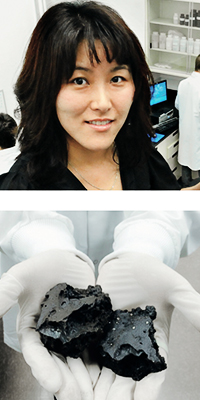From All Corners of Engineering, Sustainable Energy Solutions in the Works
The societal imperative to improve the human condition, incomes, and well-being requires energy. Even a fraction of the prodigious amounts we use in the United States goes a long way. But our dependency on seemingly abundant fossil fuels like coal, oil, and natural gas has reached a tipping point. Their continued use and their associated emissions, if unchecked, threaten the health of our environment, with varying degrees of impact across the world. Now we face a complex problem: How do we assure clean, safe, sustainable, and low-cost energy resources for today and well into the future?
 An electrochemical reactor, or electrolyzer, used for splitting water into oxygen and hydrogen fuel
An electrochemical reactor, or electrolyzer, used for splitting water into oxygen and hydrogen fuel
(Photo by Jeffrey Schifman)
“Developing and deploying affordable, sustainable energy technology at a large scale is one of the grand challenges of our time,” says Daniel Esposito, assistant professor of chemical engineering. “Columbia Engineering is strongly positioned to be an important player in the field of sustainable energy for many reasons, chief among them being a collaborative and interdisciplinary environment that leverages expertise across many disciplines for developing next-generation energy conversion technology.”
Advancing Solar Fuel Technology
A growing global population requires a secure and abundant energy supply that is not only safer for the environment, but is also more affordable. One solution lies in two of the earth’s most abundant materials: water and sunlight. Scientists like Esposito are converting sunlight into an electric current that is able to split water (H2O) into hydrogen and oxygen. The resulting hydrogen gas—which can be referred to as solar fuel owing to its production from solar energy—can be stored, transported, and used as an emissions-free fuel.
“Solar fuels are highly attractive for a sustainable energy future because they can be converted into electricity or used directly for transportation, heating, chemical processes, and more,” he explains. “Thanks to this versatility, solar fuels such as hydrogen offer an exciting opportunity for society to meet a higher percentage of its energy needs.”
“Developing and deploying affordable, sustainable energy technology at a large scale is one of the grand challenges of our time,” says Daniel Esposito, assistant professor of chemical engineering. “Columbia Engineering is strongly positioned to be an important player in the field of sustainable energy for many reasons, chief among them being a collaborative and interdisciplinary environment that leverages expertise across many disciplines for developing next-generation energy conversion technology.”
Advancing Solar Fuel Technology
A growing global population requires a secure and abundant energy supply that is not only safer for the environment, but is also more affordable. One solution lies in two of the earth’s most abundant materials: water and sunlight. Scientists like Esposito are converting sunlight into an electric current that is able to split water (H2O) into hydrogen and oxygen. The resulting hydrogen gas—which can be referred to as solar fuel owing to its production from solar energy—can be stored, transported, and used as an emissions-free fuel.
“Solar fuels are highly attractive for a sustainable energy future because they can be converted into electricity or used directly for transportation, heating, chemical processes, and more,” he explains. “Thanks to this versatility, solar fuels such as hydrogen offer an exciting opportunity for society to meet a higher percentage of its energy needs.”
 Side view of a photoelectrochemical test cell used for evaluating the performance of novel materials and electrodes employed for the direct conversion of sunlight into storable fuels such as hydrogen. Inset shows the same test cell from behind. The bright circle in the background is a Xenon Arc lamp that serves as the “artificial sun” for these experiments.
Side view of a photoelectrochemical test cell used for evaluating the performance of novel materials and electrodes employed for the direct conversion of sunlight into storable fuels such as hydrogen. Inset shows the same test cell from behind. The bright circle in the background is a Xenon Arc lamp that serves as the “artificial sun” for these experiments.
(Photo by Jeffrey Schifman)
In his lab, Esposito focuses on two solar-to-hydrogen processes: photovoltaic electrolysis and photoelectrochemical (PEC) cell technology. In photovoltaic electrolysis, traditional solar panels produce electricity, which then powers an electrochemical device that splits water into hydrogen and oxygen. The PEC cell technology is similar to photovoltaic electrolysis, but combines the solar harvesting and water splitting processes in an all-in-one device.
“Our goal is to advance these technologies by engineering innovative materials and devices that are more efficient, more durable, and easier to manufacture at a lower cost than existing state-of-the-art technologies,” says Esposito. “To achieve that goal, collaboration is imperative. The basic operation of solar fuel technology is underpinned by interdisciplinary research between materials science, physics, chemistry, engineering, and optics.”
Developing Microgrid Technology to Meet Electricity Demand
Energy is an essential factor for sustainable development as well as for poverty eradication. But in 2015, the United Nations estimated that about 2.8 billion people still had no access to modern cooking fuels and that more than 1.1 billion did not have electricity.
 Local solar microgrid for rural families in Uganda
Local solar microgrid for rural families in Uganda
(Photo courtesy of Vijay Modi)
“We must expand energy access to the poor as an urgent priority in our pursuit of sustainability goals,” says Vijay Modi, professor of mechanical engineering. “Science and technology can help meet this challenge.”
Modi collaborates with the Earth Institute at Columbia University for an interdisciplinary focus on sustainable development. Five years ago, Modi led a team to deploy 16 microgrid pilot programs to bring electricity to rural villages in Mali and Uganda. Their SharedSolar project features a small solar power plant with battery storage that serves a local 220V AC microgrid providing battery storage for 20 families or fewer. The grids are regulated by a common smart controller that manages demand, supply, and individual customer accounts. Each customer-side connection is smart metered and users prepay for their electricity either via their cell phones or through a local vendor’s phone. The system allows users to purchase electricity when they need it, in the amount they need, and with small payments, which is an important aspect of delivering power to the poor.
“This was an opportunity for us to deploy a new technology on the ground in order to understand the customer side; the payment side; the maintenance, sustainability, and long-term viability of the system. We couldn’t assume how this solution would be adopted without testing in the field,” says Modi.
The microgrid system has proved successful as a reliable solution for early-stage energy needs in poor countries, with the World Bank, the African Development Bank, and others considering them as a potential for first electricity access. The project has also proved that microgrids are an ideal way to integrate renewable resources at a local community level.
“These underdeveloped populations using the microgrid technology are pioneers who are providing the initial market demand for a next-generation power system,” says Modi. “This will inevitably lead to demand for more advanced microgrid operating systems that manage time-varying supply and diverse loads, as well as new innovations in wireless communication, low-cost energy storage, and super-efficient appliances.”
 Top: Alissa Park (Photo by Eileen Barroso); bottom: Rethinking waste to complete material cycles for sustainability like the steel slags pictured here, an example of the unconventional resources containing valuables including rare earth elements.
Top: Alissa Park (Photo by Eileen Barroso); bottom: Rethinking waste to complete material cycles for sustainability like the steel slags pictured here, an example of the unconventional resources containing valuables including rare earth elements.
Investigating Innovative Solutions for Carbon Capture and Utilization
Until alternative energy solutions are available for large-scale implementation, fossil fuel use will still predominate. So too will its emissions of carbon and greenhouse gases, which have a grave effect on our lives and environment around the world.
“As a society, we have never faced a more pressing or complex problem than carbon emissions,” says Alissa Park, associate professor of earth and environmental engineering and chemical engineering. She is also the director of the Lenfest Center for Sustainable Energy.
Park and her colleagues have worked to develop innovative solutions to capture carbon emissions before they enter into the atmosphere. In the past, reducing carbon dioxide emissions meant three separate, complex—and expensive—processes to capture, transport, and inject them deep into rock formations at carefully selected safe sites for permanent storage. Park is focusing her research on ex situ carbon mineralization, a process of tuning chemical interactions with CO2 to form solid carbonates.
“By converting CO2 into solid carbonates, we won’t need to monitor it or move it, compared to storing it as a high-pressure gas or liquid,” she explains. Park’s research has been called “the ultimate backup plan for carbon storage” because it remedies current carbon storage concerns about high-pressure gas underground and subsequent monitoring costs.
Her work is broadening the knowledge about the fundamental characteristics of the chemical reactions that produce viable ex situ carbon mineralization. It has also led her to investigate opportunities to accelerate carbonation of industrial wastes, and how the resulting material can be used for building and construction materials fillers. Park is using the mineral carbonation concept to treat iron and steel slag waste in China and recycle it for use in other industrial processes, improving the overall sustainability of how we use resources and materials.
“Remediating the global impact of carbon emissions requires a comprehensive and interdisciplinary focus,” she says. “Developing energy sustainability solutions like carbon sequestration is a big task, but with a collaborative effort we are making progress.”
